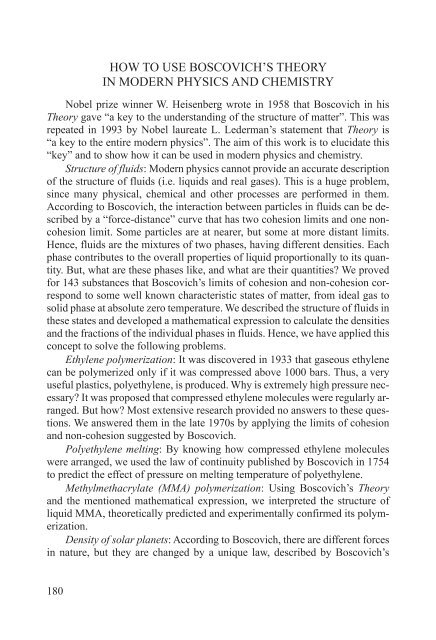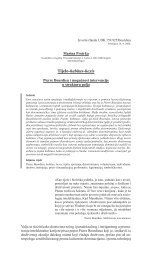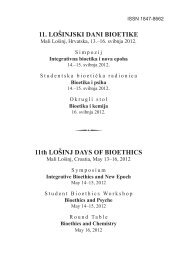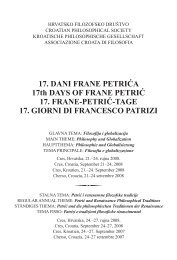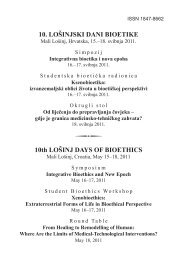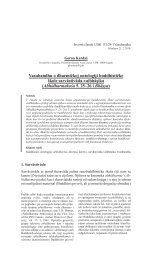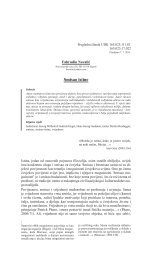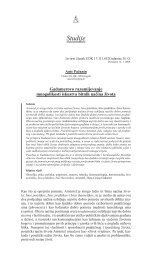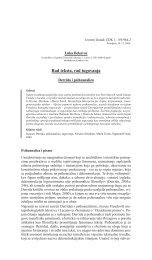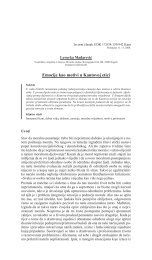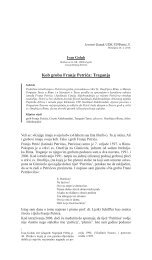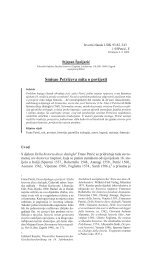Programska knjižica - Hrvatsko filozofsko društvo
Programska knjižica - Hrvatsko filozofsko društvo
Programska knjižica - Hrvatsko filozofsko društvo
Create successful ePaper yourself
Turn your PDF publications into a flip-book with our unique Google optimized e-Paper software.
HOW TO USE BOSCOVICH’S THEORY<br />
IN MODERN PHYSICS AND CHEMISTRY<br />
Nobel prize winner W. Heisenberg wrote in 1958 that Boscovich in his<br />
Theory gave “a key to the understanding of the structure of matter”. This was<br />
repeated in 1993 by Nobel laureate L. Lederman’s statement that Theory is<br />
“a key to the entire modern physics”. The aim of this work is to elucidate this<br />
“key” and to show how it can be used in modern physics and chemistry.<br />
Structure of fluids: Modern physics cannot provide an accurate description<br />
of the structure of fluids (i.e. liquids and real gases). This is a huge problem,<br />
since many physical, chemical and other processes are performed in them.<br />
According to Boscovich, the interaction between particles in fluids can be described<br />
by a “force-distance” curve that has two cohesion limits and one noncohesion<br />
limit. Some particles are at nearer, but some at more distant limits.<br />
Hence, fluids are the mixtures of two phases, having different densities. Each<br />
phase contributes to the overall properties of liquid proportionally to its quantity.<br />
But, what are these phases like, and what are their quantities? We proved<br />
for 143 substances that Boscovich’s limits of cohesion and non-cohesion correspond<br />
to some well known characteristic states of matter, from ideal gas to<br />
solid phase at absolute zero temperature. We described the structure of fluids in<br />
these states and developed a mathematical expression to calculate the densities<br />
and the fractions of the individual phases in fluids. Hence, we have applied this<br />
concept to solve the following problems.<br />
Ethylene polymerization: It was discovered in 1933 that gaseous ethylene<br />
can be polymerized only if it was compressed above 1000 bars. Thus, a very<br />
useful plastics, polyethylene, is produced. Why is extremely high pressure necessary?<br />
It was proposed that compressed ethylene molecules were regularly arranged.<br />
But how? Most extensive research provided no answers to these questions.<br />
We answered them in the late 1970s by applying the limits of cohesion<br />
and non-cohesion suggested by Boscovich.<br />
Polyethylene melting: By knowing how compressed ethylene molecules<br />
were arranged, we used the law of continuity published by Boscovich in 1754<br />
to predict the effect of pressure on melting temperature of polyethylene.<br />
Methylmethacrylate (MMA) polymerization: Using Boscovich’s Theory<br />
and the mentioned mathematical expression, we interpreted the structure of<br />
liquid MMA, theoretically predicted and experimentally confirmed its polymerization.<br />
Density of solar planets: According to Boscovich, there are different forces<br />
in nature, but they are changed by a unique law, described by Boscovich’s<br />
180


